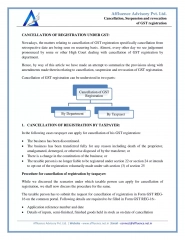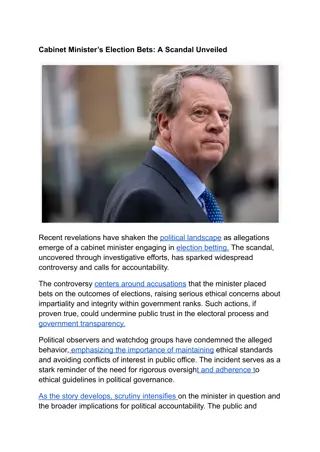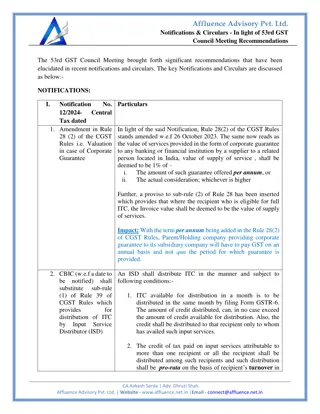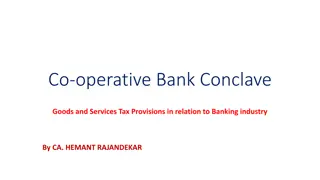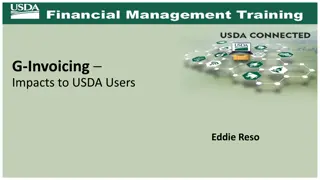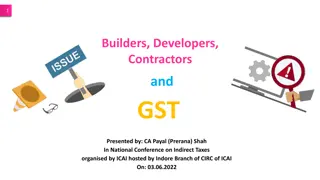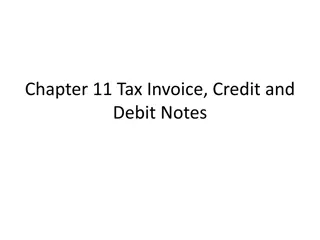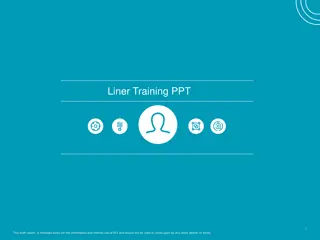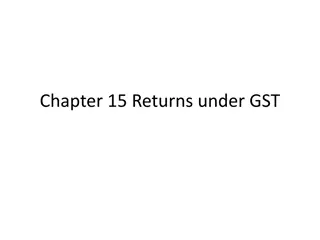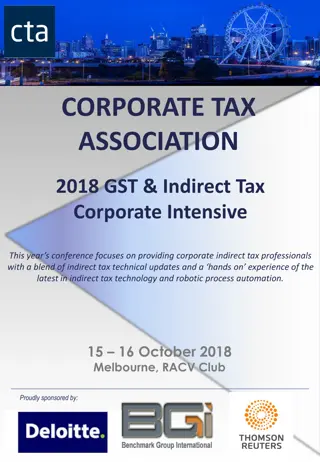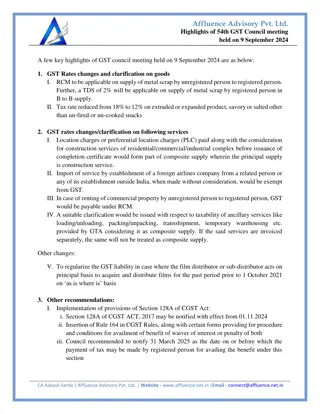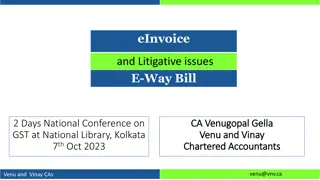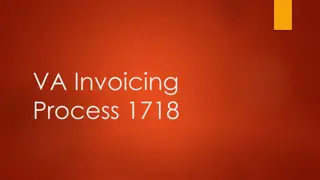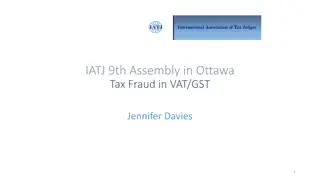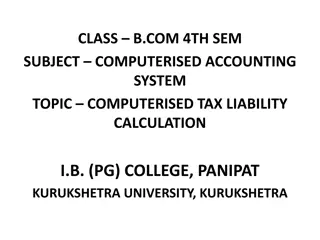Alleged Fake Invoicing Scandal Unveiled in GST Case Study Panel Discussion
ABC Ltd, a steel manufacturing company, is embroiled in an alleged fake invoicing scandal involving multiple parties. The Managing Director's shocking confession on social media revealed inflated invoicing practices, triggering investigations and potential repercussions for the parties involved. The case highlights the complexities and consequences of fraudulent invoicing in the GST system.
Download Presentation

Please find below an Image/Link to download the presentation.
The content on the website is provided AS IS for your information and personal use only. It may not be sold, licensed, or shared on other websites without obtaining consent from the author. Download presentation by click this link. If you encounter any issues during the download, it is possible that the publisher has removed the file from their server.
E N D
Presentation Transcript
R e g i o n a l G S T C o n c l a v e a t R a j k o t 23rd July, 2022 Panel Discussion on Assorted Case Studies GST Rajkot Branch of WIRC of ICAI
Case Study 5 Alleged Fake Invoicing / Circular Trading
Facts of the Case ABC Ltd is a listed company and is engaged in the manufacturing of steel at various plants and has an aggregate manufacturing capacity of 50 Mn TPA. It has an arrangement with four distributors whereby the entire production for domestic consumption is supplied to these four distributors only on a P2P Model. Over and above the domestic supplies, ABC Ltd directly exports goods outside the country. PQR Ltd. Is one of the distributors in Karnataka which has purchased steel aggregating to 10 Mn. T during the last year from ABC Ltd. In turn, PQR Ltd has immediately sold the said steel to its group company XYZ Ltd so as to obtain bank financing. XYZ Ltd thereafter sold these goods to DEF Ltd, a trader in Gujarat. However, under instructions from DEF Ltd, the goods were directly shipped to Buildcon, a builder developer located in Maharashtra.
Facts of the Case All the parties possess proper tax invoices, inventory records, transport proofs and eway bills for the said transactions. The taxes have been duly paid by the respective parties and input tax credit reflected in GSTR2A. All the parties have claimed the input tax credit, except Buildcon who does not claim input tax credit being governed by a specific restrictive notification. The payments between the parties have also been settled by normal banking channels. To reiterate, the series of transactions and invoicing is as under. ABC Ltd. PQR Ltd. XYZ Ltd DEF Ltd Buildcon - transactions for 10 Mn. T
Facts of the Case One fine day, the Managing Director of ABC Ltd recorded a video confession and shared the same on social media. Without going into specifics, he admitted that due to market expectations, he had indulged in fake invoicing and though the actual production was around 40 Mn T, ABC had issued invoices to the extent of around 120 Mn T. He further stated that it was like he was riding a tiger and could no longer sustain. After sharing the video on the social media, the Managing Director committed suicide. To reiterate the quantitative details: Production Capacity 50 Mn. T. Actual Production admitted by Managing Director 40 Mn. T. Invoices issued 120 Mn. T. Supplies made to PQR one of the distributors 10 Mn. T
Facts of the Case All investigating agencies immediately sprung into action. The DGGI also took upon itself to investigate this issue and recorded statements from all the above parties. Each of the parties (except ABC Ltd.)asserted that their transactions are indeed genuine and provided all possible documentation to explain their transactions. However, the DGGI appeared to have a pre-conceived mind and is expecting PQR,XYZ and DEF to reverse the entire input tax credit claimed along with interest and 15% penalty. It is also expecting Buildcon to either pay the tax under RCM under Notification 7/2019-CT(Rate) (on the presumption that the actual supply was from an unregistered dealer) and/or to pay a penalty under section 122 for receiving an invoice without receiving the goods and/or services.
Issues The following issues emerge from the above fact background: 1. What is the extent of documentation and the burden of proof to establish the genuineness of the supplies? 2. What would be the evidentiary value of the video confession recorded by the Managing Director? Assuming that most of the officers down the line in the company would claim ignorance and may not corroborate the findings of the Managing Director, what could be the line of defence for the distributor and other parties? 3. If the officers down the line in the company do corroborate the findings of the Managing Director in generality without going into specifics, what would be the rights of the distributor and the other parties? At what point of time, should the right of cross examination be exercised?
Issues 4. In the absence of revenue loss purely from GST Perspective, can the action of the DGGI be justified? 5. Can each of the parties mentioned above be implicated? Would it not result in multiple jeopardy? 6. Would the situation change if one of the four parties mentioned above succumbs under pressure and agrees to the Department allegation of fake invoicing? 7. Can the action against Buildcon be justified considering the fact that there is no input tax credit claimed by it? 8. If the other parties voluntarily reverse the credit along with interest and 15% penalty, does it mean closure of all proceedings in this regard?
Case Study 2 Scrutiny of Returns
Facts of the Case M/s B Ltd has been issued ASMT-10 for Financial Year 2017-18 informing discrepancies noticed by proper officer on scrutiny of monthly returns under Section 61 of the Act. It has following discrepancies/ clarifications sought from B Ltd.: a) Difference in value of outward supplies as reported in GSTR-1 vis- -vis as reported In E-Way Bill data for Rs 25 lacs. b) Claim of ITC in respect of supplies from taxpayers whose registrations have been cancelled retrospectively for Rs 4 lacs. c) ITC availed in respect of Import of goods in Table 4(A)(1) of FORM GSTR-3B verified with corresponding details in Table 10 and Table 11 of FORM GSTR-2A and not appearing to the extent of Rs 3 lacs. d) Further M/s B Ltd has been called upon to explain calculation of ITC which has been reversed and shown in GSTR-3B as per Rule 42 and 43 of the CGST Rules? M/s B Ltd has been given a time of 14 days to reply to the ASMT-10 in ASMT-11.
Issues In respect of same, M/s B Ltd has following queries: 1) Who is the proper officer for the purposes of issuance of ASMT-10? 2) Whether scrutiny of monthly returns can be undertaken by proper officer when GSTR-9 and GSTR-9C have already been filed by it? 3) Whether one consolidated ASMT-10 can be issued for whole financial year considering scrutiny of monthly returns has been done and financial year in that context is not a tax period ? 4) Whether discrepancy as mentioned in point no (a) above is covered within the scope of Section 61of the Act? 5) Whether M/s B can be called upon to explain the manner of working of reversal of ITC as per Rule42 and 43 in ASMT-10 proceedings? 6) Whether officer can bind M/s B Ltd to reply to ASMT-10 before expiry of 30 days in accordance with Section 61 read with Rule 99?
Issues The reply submitted in ASMT-11 was taken on record and DRC-01 was issued under Section 74 of the Act by the Superintendent. In respect of same M/s B has following additional doubts: 1) Whether Superintendent has violated the provisions of Rule 142(1A) by not issuing DRC-01A prior to issuance of DRC-01? In what circumstances officer is duty bound to issue DRC-01A prior to issuance of DRC-01? 2) Whether Superintendent is correct in his jurisdiction to issue DRC-01?
Case Study 1 Error in availment of ITC
Facts of the Case A taxpayer purchases goods from a multi-locational vendor. During the period of 2018- 2019, while recording the invoices, there were certain errors by virtue of which: 1. Supplies received from Gujarat with IGST were booked as supplies from Maharashtra and accounted as CGST & SGST in books 2. Supplies received from Maharashtra with CGST/ SGST were booked as supplies from Gujarat and accounted as IGST in books The credit was accordingly claimed in GSTR 3B/ disclosed in GSTR 9.
Issue During investigation proceedings on the taxpayer, objection was raised on the following grounds: 1. That in case of the above supplies against whom credit is appearing in books and claimed in returns was in violation of Section 16 as the taxpayer is not in possession of valid tax invoice, the same are not matching with GSTR 2A, etc., 2. The time-limit to claim correct credit has now lapsed u/s 16 (4).
Facts of the Case Certain credit notes in relation to outward supplies were also issued during the year. However, while filing GSTR 3B, instead of recording it as a reduction in output liability, the taxpayer has disclosed it as input tax credit. The same is also sought to be denied to the taxpayer though the same is revenue neutral. How should the taxpayer approach both the above situations? Would the answer change if the tax payer had rectified this disclosure error in GSTR 9, though not in GSTR 3B?
Case Study 6 Recovery prior to Adjudication
Facts of the Case Mr. Mehra runs the proprietary trading business. In March 2021, there was a search operation carried out under section 67 of the Act. The search was conducted both at the business premises as well as at the residence of the proprietor. During the course of search, unaccounted cash to the extent of Rs. 20 lakhs was found at the business premises and unaccounted cash of Rs. 50 lakhs was found at the residence of the proprietor. Also, there was stock shortage to the extent of Rs. 10 lakhs. Further, one month reconciliation of the supplier s ledger suggested that there could be under-reporting to the extent of around Rs. 30 lakhs per month. Accordingly, the search party alleged a turnover evasion for 45 months since July 2017 and considering the subdued demand due to pandemic worked out the estimated tax evasion as under:
Facts of the Case Period from 1st July 2017 to 28th February 2020 (turnover evasion estimated at 200% of evasion during the pandemic period) i.e. 60 lakhs p.m. x 32 - 1980 lakhs Period from 1st March 2020 till 28th February 2021 being pandemic period turnover evasion @ 30 lakhs per month x 12 months - 360 lakhs Total Turnover Evasion 2340 lakhs GST @ 18% on evaded turnover 421 lakhs The search party also observed that there is mismatch of ITC to the tune of Rs. 1 Crore. Accordingly, in the view of the search party, the total tax evasion exceeded 5 crores.
Facts of the Case The search party therefore started threatening Mr. Mehra to concede and pay up the above amount to avoid arrest. Further, the cash of Rs. 70 lakhs was seized and the bank accounts were attached. The search party not only attached the bank accounts of Mr. Mehra but also of his father who had independent business of his own. Further, a prohibition order was issued to not sell or dispose off the pending stock, resulting in effective disruption of business. The business has certain amount of debtors in its books of accounts. The search party also issued garnishee orders under section 79 to such debtors.
Issues Please advise Mr. Mehra on the further course of action, specifically:- 1. Whether the tax evasion can be estimated based on the presumptions mentioned above? 2. Mr. Mehra defends that the unaccounted cash is actually explained through the sale of personal jewellery and is not from the business generated. Is this a plausible defence? 3. Mr. Mehra further explains that the stock shortage is due to the fact that certain entries were not passed in the system and the same can be explained. Similarly, the difference in supplier s ledger reconciliation can be explained and there is no evasion at all. However, the search party is not receptive to the explanations so provided. What is the recourse in such a scenario? 4. If Mr. Mehra pays the lumpsum amount of Rs. 1 Crore to bring the disputed amount below Rs. 5 Crore, Can arrest be avoided?
Issues 5. Can cash be seized by the search party? 6. Can the stock prohibition order be issued to disrupt the business of the tax payer? 7. Can bank accounts of relatives be attached even if they are not taxpayers? 8. Can such attachment (of cash, bank accounts and debtors) be undertaken pending the issuance of the SCN or the adjudication order? 9. What are the alternative remedies in such cases?
Case Study 3 ITC Reversal
Facts of the Case (a)The company M/s. X is engaged in the manufacture and sale of Bournvita. They have floated the scheme for dealers under which the dealer is entitled to receive refrigerator, television, microwave-oven and other items depending upon the quantum of sale achieved by them. M/s. X has procured these items and availed the credit and have supplied these items to the dealer asper the eligibility given in the circular. The department is proposing to deny the credit on these items. M/s. X has approached you for advice. Would your answer be different if there is no scheme floated by M/s. X for providing these items to dealer before supply of materials? However, the company subsequently decides to provide the items as a measure of good will.
Facts of the Case (b) Mr. Mukesh, a self-employed software professional, has purchased a laptop worth Rs. 1 Lac plus GST and a mobile phone worth Rs. 1 Lac plus GST under a Tax invoice. In his books of accounts he has capitalized the assets net of GST and has taken ITC of the GST purchased. He disallows 20%of the depreciation and repairs for computing profits and gains of business under the Income-tax Act, 1961 as being expenditure incurred for personal use. How much ITC would be available to Mr. Mukesh?
Facts of the Case (c) ST Ltd. supplies exempt goods and taxable goods. The goods are stored in a common warehouse which it has taken on rent under one agreement for which it receives a single invoice from the landlord indicating a single amount as rent. Both the goods are, however, stored in earmarked areas and never mixed. The taxable goods occupy 95% of the area and the exempt goods occupy 5% of the area. However, due to high unit price of the exempt goods, the turnover of exempt goods constitute 40% of the turnover. ST Ltd. has apportioned the ITC on rent for each invoice based on area basis and taken the resultant ITC attributable to taxable goods. The tax officer has questioned this method of apportionment and contends that it is not in line with rule 42 which prescribes a turnover basis of apportionment.
Facts of the Case Issues for Deliberation: Rule 42 provides statutory formula for working out non-eligible ITC pertaining to exempt supply. It does not specifically permit apportionment of input tax credit based on scientific or reasonable basis. In view of this, whether ST Ltd. is justified in following apportionment based formula for reversal of ITC attributable to exempt supply?
Facts of the Case (d) Jalsa Ltd. celebrated its 100th Anniversary in the month of April 2021 and for this purpose, the company gifted house, cars, gold coins, etc to all its employees depending on their designation and seniority in the company. Jalsa Ltd. has availed credit on these gift items and their auditor has raised a query stating that they cannot avail credit on these items as they are not dealing in these products. What would be the position if the expenditure is treated as part of perquisites in Income Tax and included in Salary cost of the respective employee? Whether answer will be different if the Offer letter with the employee specifies that gifts will be given to employee based on performance?
Case Study 4 Multiple Proceedings
Facts of the Case A taxpayer was inspected by State authorities and certain discrepancies emerged from its books of accounts as follows (A) GSTR-2A v/s GSTR-3B (B) Blocked input tax credit (C) Difference between GSTR-1 and 3B. The basis for inspection was high ITC utilisation by the taxpayer without any cash payment for a long period of time. Simultaneously, scrutiny assessment proceedings were initiated by the State proper officer on issue (A) and (B) vide two separate notices. Summons were issued by Anti-Evasion Central Authorities on the ground of possibility of fake invoicing with two vendors (X) who s invoice was appearing in GSTR-2A and (Y) who s invoice was not appearing in GSTR-2A.
Facts of the Case DGGI has also issued summons based on DGARM report on the ground of suspicious activities with two other vendors who have not engaged made any cash payment since introduction of GST and some suppliers above the vendors admitted to Bill trading. Amidst all this, GST audit was directed to be performed which was concluded proposing reversal of input tax credit on account of issue (A) and (B) and not raising any issue on theGSTR-1 / GSTR-3B difference. All the above proceedings are pending before multiple authorities.
Issues Advise the tax-payer on its rights such as a) Merging the jurisdiction at one location b) State inspecting authority having a different conclusion on issue (C) vis- -vis the audit report being silent on this aspect c) Questioning the jurisdiction of any of the above authorities on the presumption that these proceedings were initiated in the same sequence as being enlisted above d) Annual return before Inspection by the authorities is due to be filed based on statutory timelines e) In many instances the assessment order in ASMT-12 is not issued and no adjudication is proposed u/s 73/74 by the proper officer. Can adjudication be initiated by the very same officer on account of an audit observation and reports from inspecting authority after a period of 1 year from the issuance of ASMT-10
Issues f) With information available on record the officer confirms the demand u/s 74 on issue (A) & (B) and drops the issue for (C). g) Certain tax was paid on lumpsum basis during the inspection on account of coercion without mentioning under protest and also lack of a direction towards any particular issue. The proper officer to appropriates this tax only towards issue (A) and (B) and chooses not to refund the same on the basis of issue (C) this tax payment is more than the mandatory pre-deposit requirement. h) The revisionary authority claims that the adjudication is erroneous in so far as it is prejudicial to interest of revenue since the proper officer has not (a) awaited the report of DGGI whose proceedings are pending (b) Central authorities have issued a report that the taxpayer has not received goods in certain cases and hence not eligible for input tax credit.
Issues Examine of all these scenarios sequentially with advise the tax payer to address each situation on legality of the proceedings under the CGST/SGST Act.







